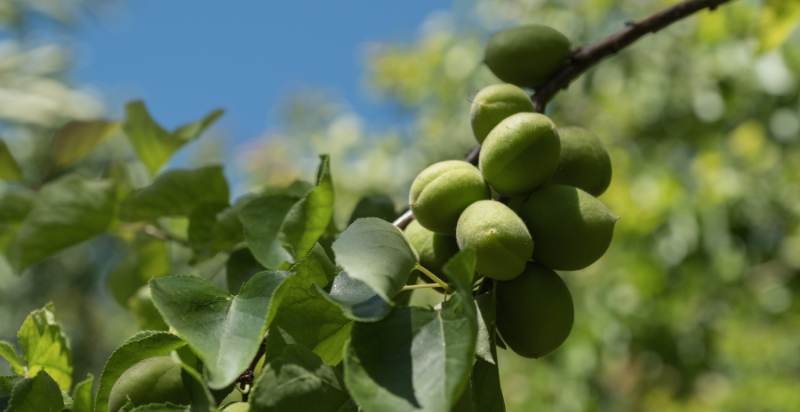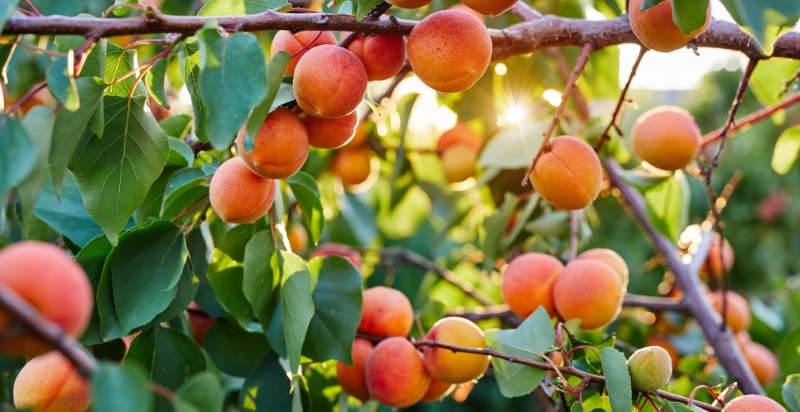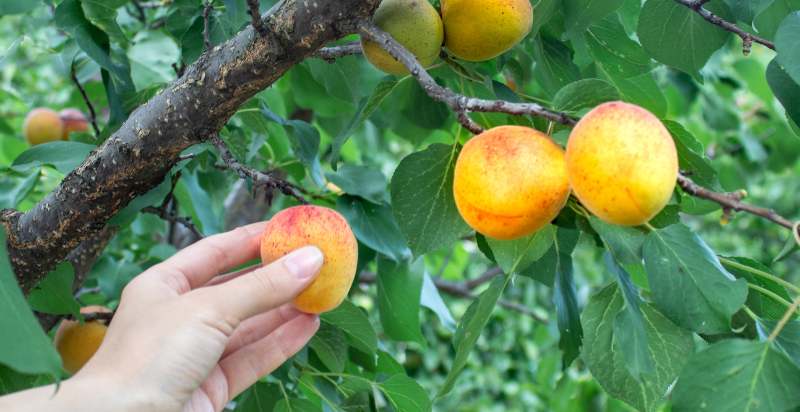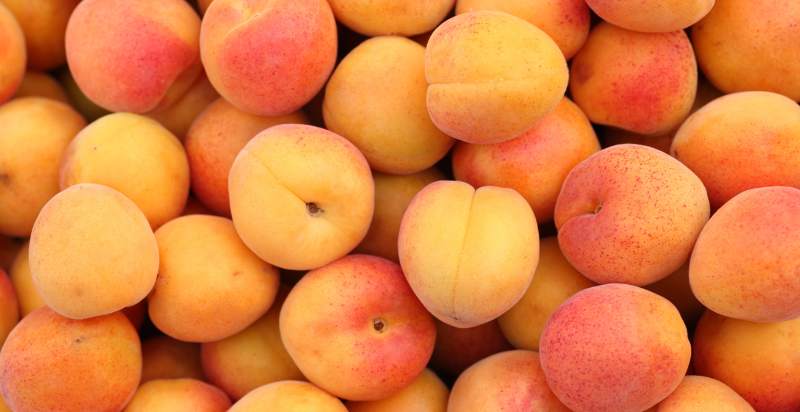The Apricot is an incredibly versatile and healthy fruit enjoyed in many cultures for centuries. It’s native to the dry regions of Central Asia, but today can be found all over the world thanks to its easily transportable nature. Apricots contain vitamins and minerals, including vitamins A and C, calcium, iron, magnesium, phosphorus, and potassium. They also contain dietary fiber and a range of antioxidants that can promote good health. This article will explore some of the amazing benefits associated with apricots.
What are Apricots?
The Apricot is a round, orange fruit with a tart flavor. It has thin, smooth skin and juicy flesh ranging from yellow to an intense orange-red color. The pit of the apricot is usually removed when eaten fresh or dried. Apricots are available year-round in many parts of the world, although they are typically harvested between May and August.
History and Origin of Apricot:
The apricot is an ancient fruit, originating in China and the surrounding areas of Central Asia centuries ago. The fruit was introduced to the Mediterranean region by Alexander the Great and spread throughout Europe in the following centuries. Apricots were then brought to North America with Spanish explorers, where they quickly became a popular crop for their sweet taste, versatility as a food, and medicinal properties.
Today, apricots are cultivated around much of the world and have become one of the most common fruits in grocery stores. Depending on where they are grown, they come in various colors, from yellow to deep orange-red and even purple varieties. Apricots have a unique flavor that ranges from sweet to tart depending on ripeness when picked and can be enjoyed in a variety of dishes and sweet treats.
In addition to their delicious taste, apricots are highly nutritious, with high amounts of vitamins A and C and dietary fiber. They also contain antioxidants which have been linked to health benefits such as improved digestion, heart health, and even cancer prevention. For this reason, apricots are gaining popularity among health-minded individuals looking for an easy way to add more fruits to their diet.
No matter where they’re grown or how they’re enjoyed, apricots will always remain one of the world’s oldest and most beloved fruits! Whether you eat them fresh off the tree or use them in recipes like pies and jams, you can’t go wrong with this delicious and nutritious fruit. So remember to pick up a few apricots next time you head to the grocery store, or if you’re lucky enough to have an apricot tree in your backyard, try some of these recipes and enjoy the rich flavor of this ancient fruit!
Varieties of Apricot:
Apricots come in many shapes and sizes, from the large and firm ‘Royal’ variety to the small and sweet ‘Moorpark.’ The skin color of apricots ranges from golden yellow to orange-red. Depending on the variety, they may have a soft or crunchy texture. Apricot flesh is juicy and tart with a hint of sweetness.
The most popular varieties of apricot are:
- Royal – This large, oblong-shaped fruit has a firm texture and deep orange skin. The flesh has an intense flavor that’s both sweet and tart.
- Moorpark – These plump fruits have smooth skins ranging from pale yellow to bright orange. The flesh is juicy and sweet, with a hint of tartness.
- Katy – This small apricot has yellow-orange skin and firm flesh that’s sweet and juicy.
- Tilton – These round fruits have a deep orange skin and a sweet flavor.
- Blenheim – This large variety has orange-red skin, firm flesh, and intense sweetness.
- Goldrich – These medium-sized apricots have light orange skins and sweet, juicy flesh.
- Early Orange – This small fruit has bright orange skin and a mild flavor.
- Chinese – With its smooth yellowish-green skin, this tart variety is often used for preserves.
No matter which variety you choose, apricots are a great source of vitamin C and fiber. They can be eaten fresh or used in recipes such as pies, jams, compotes, and sauces. Enjoy!
Nutritional Value of Apricot:
Apricot is a nutrient-dense fruit that packs many essential vitamins and minerals in every small serving. One cup of fresh apricots provides nearly 10 percent of the daily value for fiber and 16 percent of vitamin A, 11 percent of vitamin C, 5 percent calcium, and 4 percent iron. Apricots also contain important antioxidants such as beta carotene, lutein, and lycopene which help to protect against oxidative stress. Apricots are also packed with potassium and other electrolytes like magnesium and sodium, which help keep your body hydrated.
When it comes to health benefits associated with consuming apricots, one major advantage is their impact on blood sugar levels due to their low glycemic index (GI). Apricots are also rich in dietary fiber, which helps to regulate digestion and promote regular bowel movements.
The vitamin A content of apricots provides antioxidant benefits that support the immune system, while the high levels of beta carotene can help protect your skin from sun damage. Apricots are also a good source of potassium, essential for maintaining healthy blood pressure levels and keeping your heart healthy.
In addition to having many nutritional benefits, apricots are also delicious. They can be eaten fresh or dried and make a great snack or added to salads and other dishes for extra flavor. Dried apricots also add sweetness without calories when baking or making smoothies.
Overall, apricots are a nutritious and delicious addition to any diet. They provide a variety of essential vitamins and minerals, fiber, antioxidants, and electrolytes, which all help support overall health. So go ahead and enjoy the sweet taste of apricots today!
Health Benefits of Apricot:
Apricots are considered to be highly nutritious and have a variety of health benefits. They are low in calories, high in dietary fiber, and loaded with vitamins A, C, E, and K. Apricots also contain iron, calcium, magnesium, and phosphorus, making them extremely healthy for you.
One of the most important health benefits of apricots is that they can help reduce cholesterol levels. They contain compounds called phytosterols which have been found to lower LDL (bad) cholesterol levels by blocking its absorption into the body. Additionally, apricots are rich in vitamin C, which helps protect against heart disease by boosting immunity and preventing oxidative damage to cells.
Apricots are an excellent source of antioxidants. These powerful compounds protect the body from free radical damage, reducing inflammation and slowing aging. They are also known to reduce the risk of certain types of cancer, especially lung and breast cancer.
In addition to their nutritional benefits, apricots have been used in traditional medicine for various ailments such as diarrhea, constipation, and fever. Their high fiber content helps keep you regular, while their anti-inflammatory properties can help soothe an upset stomach or reduce fever-related symptoms.
The health benefits of apricot extend to skin care as well. Apricots contain several vitamins that help keep your skin looking young and wrinkle-free. The vitamin C in apricots is an antioxidant to reduce sun damage, while the carotenoids found in apricots can help reduce wrinkles. Apricots are also a great source of vitamin A which helps protect your skin from environmental stressors such as pollution and UV rays.
Overall, apricots are a nutrient-dense food that should be incorporated into any healthy diet. They contain several essential vitamins and minerals that can provide numerous health benefits, including reducing cholesterol levels, boosting immunity, and protecting against free radical damage. Additionally, they have been used in traditional medicine to treat various ailments, and their high fiber content makes them excellent for digestive health. So next time you’re looking for an easy snack jam-packed with nutritional goodness, reach for an apricot.
What are the Uses of Apricots?
An Apricot is a versatile fruit that can be used in many different ways. It has abundant health benefits, making it one of the most popular and beneficial fruits you can enjoy. Here are some of the many uses for apricots:
- Eating raw – Apricots are delicious right out of the can or freshly picked off the tree! They make a great snack, and their sweet flavor goes well with salads, yogurt, oatmeal, and smoothies.
- Baking – Dried apricots work well in baking recipes such as bread and muffins or even added to homemade granola bars or energy bites. They give food a naturally sweet taste without having to add extra sugar.
- Making jam – Apricot jam is an easy and delicious way to enjoy this summer fruit all year round. All you need is some fresh or canned apricots, sugar, lemon juice, and some time to cook it down into a sweet spread.
- Adding to sauces and dressings – Apricot makes a great addition to any sauce or dressing recipe. It adds a delightful sweetness and nutritional benefits such as Vitamin A and fiber.
- Making tea – Dried apricots can be steeped in hot water for several minutes to make an aromatic herbal tea packed with antioxidants and anti-inflammatory compounds. This tea can be enjoyed either hot or cold.
- Creating desserts – Apricots can be used in all dessert recipes, from cakes and pies to cobblers and crisps. They also make a great addition to ice cream or yogurt for a tasty treat.
- Flavoring drinks – Apricot-flavored beverage mixes can be found in many grocery stores and specialty shops. These provide a delicious way to enjoy the flavor of apricots without buying fresh fruit.
No matter how you use them, apricots will surely add flavor and nutrition to your life! Enjoy this summer fruit while it lasts!

How to Plant Apricots?
An Apricot is a type of fruit tree that can be grown in many parts of the world. It is an important crop for backyard gardeners as well as commercial orchards. Growing apricots is not difficult, but there are some considerations to remember when planting and caring for your trees. This article will cover all you need to know about how to plant apricot trees and care for healthy, productive plants.
Selecting the Right Apricot Tree:
When selecting an apricot tree to plant, choose one with a good reputation for producing quality fruit. Different varieties may have different fruit flavors and sizes, so research each before deciding which one you want to purchase. Also, consider the climate in which you will be planting. Some varieties may not do as well in certain climates, so choose one suitable for your area.
Preparing the Planting Site:
Choose a sunny location with plenty of airflows and well-draining soil. Apricot trees prefer slightly acidic soil with a pH between 6 and 7, so it’s important to test your soil or amend it before planting. Also, ensure there are no other fruit trees nearby that could cross-pollinate with your apricot tree, resulting in poor quality or unmarketable fruits.
Planting Your Apricot Tree:
When planting an apricot tree, dig a hole twice as wide as the root ball and deep enough to cover the roots. If you are planting more than one tree, space them out at least 18 feet from one another. Place the tree in the hole and gently fill it with soil. Press down gently on the soil as you go so that there are no air pockets around the root ball. Water deeply after planting and mulching around the tree’s base to protect against weeds and moisture retention.
Caring for Your Apricot Tree:
Once your apricot tree is planted, keep it watered regularly during its first few growing seasons to ensure healthy growth. Prune any dead or diseased branches every spring to encourage proper airflow and light penetration throughout the canopy. If pests become a problem, spray the tree with a suitable insecticide or fungus fighter.
Harvesting Your Apricots:
When your apricot tree becomes mature, you can expect to harvest fruits in the late summer months. Fruits are usually ready when they have reached full size, and their skin turns green to yellowish-orange. To pick them, gently twist each fruit and pull it off the branch. After harvesting, store your apricots in a cool, dry place until you are ready to use them.
Apricots can be a rewarding addition to any garden or orchard if cared for properly with the right growing conditions and attention. With a careful selection of variety and diligent maintenance of your trees, you can enjoy a fruitful harvest for many years to come.
How to Care for and Grow Apricots?
Apricots are a wonderful fruit to grow in the home garden. They require moderate watering and full sun for optimal growth but can also be grown in partial shade with some success. When planting apricot trees, choose a well-draining site that will not become waterlogged during the rainy season. Plant your tree, so its root system is deeply buried in the soil. The roots should be 1-2 feet deep and spread out widely.
Fertilize at least once each season using an organic fertilizer formulated for fruit trees, such as composted manure or blood meal. If needed, prune off any dead or diseased branches throughout the growing season to encourage healthy, vigorous growth. Also, remove all crossed or rubbing branches.
Apricots require excellent drainage and slightly acidic soil with a pH of 6.0-6.5. If your soil is too alkaline, add sulfur or other acidifying additives to reduce the pH level. You can also test your soil at home using a simple soil testing kit available from garden centers or online retailers.
To keep pests away:
- Use insecticides or organic pesticides such as Bacillus thuringiensis (BT) every 1-2 weeks throughout the growing season.
- Monitor carefully for signs of aphids, caterpillars, mites, thrips, and scale insects that may be attracted to the plant’s sap or leaves.
- Prune off any affected areas immediately and dispose of them away from your garden.
Apricots will bear fruit in the second or third year of growth. Once the tree begins to produce, you can harvest by hand when the fruits are ripe and firm. To ensure a healthy crop each season, practice good crop rotation practices, such as planting different crops in different sections of your garden each year. This helps prevent pests and diseases from building up in any area over time.
Finally, pruning and thinning are important tasks for caring for and growing apricot trees. Pruning should be done in early spring, just before the tree starts to bloom, and thinning should be done after harvest. Pruning will help maintain a desirable shape and size, while thinning will allow more light and air circulation into the tree, which can help improve fruit production. Use sharp pruners or loppers when doing this work for the best results.
By following these tips, you’ll be well on your way to having a healthy and productive apricot tree!

Preventions from Pests and Diseases of Apricot:
Apricots are one of the most popular fruits for home gardeners. But like any other fruit, they can be susceptible to pests and diseases if proper care is not taken. Here are some tips to help prevent pests and diseases in your apricot tree:
- Planting: When planting an apricot tree, choose a location with well-drained soil that gets plenty of sunlight. Ensure the area has good air circulation, as this reduces the risk of disease. Also, avoid planting too close to other trees or shrubs.
- Watering: Although apricots need regular watering during their growing season, it’s important not to overwater them as this can lead to root rot.
- Pruning: Proper pruning is essential to encourage healthy growth and production of apricots. Prune trees in late winter or early spring before they start blooming. This will remove dead or diseased branches and keep an apricot tree healthy and productive.
- Pest Control: Apricots can be susceptible to various pests such as aphids, caterpillars, scale insects, mites, and Japanese beetles. Monitoring these pests is important as early detection will help prevent damage from becoming too severe. Using insecticidal soaps or horticultural oils may help control infestations if used regularly throughout the season.
- Disease Prevention: Diseases are a common problem in apricot trees. The most serious diseases affecting apricots are blight, brown rot, and leaf curl. Keeping your tree healthy through proper watering and pruning can help reduce the risk of disease. Removing any infected branches or fruit from the tree immediately is also important to prevent disease spread.
These tips will help keep your apricot tree healthy and productive year after year!

How to Harvest Apricot?
Harvesting apricots is a rewarding experience and can be done in a few simple steps.
Step 1: Identify when the fruit is ripe for harvesting. Apricot fruits are ready to pick when they no longer feel firm when gently squeezed but retain some original shapes. Furthermore, the background color of the fruit should have changed from green to yellow-orange.
Step 2: Wear protective clothing and use gloves if necessary. This will help keep away any pests trying to feed on your apricots before you do!
Step 3: Use pruning shears or clippers to cut the apricot’s stem carefully, careful not to damage the tree. The fruit should come away easily without much force. If the apricot does not come away, then it may still be unripe and will need more time to ripen on the tree before harvesting.
Step 4: Gently place each piece of fruit in a basket or box for transport back to your kitchen. Be sure that none of the fruits are damaged when placed in the container, as this can reduce shelf life and lead to spoilage.
Step 5: Enjoy eating your fresh apricots! Apricots taste great raw but can also be used in recipes such as jams, pies, muffins, and more! Keeping them refrigerated is recommended for longer storage times. However, they can also be frozen for up to a year.
Harvesting apricots is an easy and rewarding experience that can be done in just a few simple steps! So get out there and start harvesting your delicious apricots today!

How to Store Homegrown Apricots?
Storing homegrown apricots is a great way to enjoy your harvest throughout the year. Apricots are fragile and will not last long on the shelf, so proper storage techniques are important for extending their shelf life. Here are some tips for storing homegrown apricots:
- Refrigeration: For short-term storage of up to several weeks, refrigerate apricots in a plastic bag or airtight container. The optimum temperature for storing apricots is 32-41 degrees Fahrenheit (0-5 Celsius). To help retain moisture, add a damp paper towel or cloth inside the bag or container.
- Freezing: Place ripe apricot halves onto a parchment-lined baking sheet and freeze until solid. Once frozen, transfer to an airtight bag or container and store in the freezer. Frozen apricots can last up to six months.
- Drying: Sun-dried apricots are a tasty snack and perfect for adding to trail mix or cereal. Start by washing ripe apricot halves in cold water before drying them on racks in direct sunlight for two to three days until completely dry. Store sun-dried apricots in an airtight container for up to one month.
- Canning: Pressure cooking is the best way of preserving homegrown apricots as it will help ensure that all bacteria are eliminated from your jars of canned fruit. Use a syrup of your choice when canning apricots, such as light or medium. Sterilize the jars before filling them with apricot halves and syrup. Once sealed, store in a cool place away from direct sunlight.
These are just some tips for storing homegrown apricots and ensuring you can enjoy their flavor for months. For more information about caring for and preserving your harvest, check out online resources or consult a local expert!

How to Use Homegrown Apricot in your day-to-day life?
Homegrown apricots can add unique flavor and nutrition to your day-to-day life. Here are some easy ways to make the most out of this delicious fruit:
- Use it as a topping on breakfast cereal, oatmeal, yogurt, or even pancakes. The sweetness of the apricot complements these dishes nicely and adds a source of fiber and vitamins to your diet.
- Make a quick snack with dried apricots by adding nuts, seeds, coconut flakes, or dark chocolate chips to boost taste and texture.
- Whip up an easy jam using homegrown apricots by blending them with sugar, water, and lemon juice until desired consistency is reached. This homemade version is much healthier than store-bought jam.
- Include apricot in savory dishes such as salads, stews, and stir-fries to add a sweet flavor balance and nutrient boost.
- Add chopped apricots to your favorite muffin recipe or make homemade granola bars with the dried version for an added crunchy texture.
- Use it in smoothies, shakes, or smoothie bowls with nut butter, spices and other fruits for a refreshing and nourishing treat.
- Make a homemade compote by simmering fresh homegrown apricots with cinnamon and sugar until thickened – perfect for topping over pancakes, waffles, or French toast!
Homegrown apricots can be an excellent addition to your diet and lifestyle. With their unique sweet flavor, they can make meals more enjoyable while also providing essential vitamins and minerals. Try incorporating them into recipes or adding them to topping existing dishes for a nutritious boost with extra flavor. You can even snack on the dried version, make homemade jam, or compete with fresh ones. Get creative and find ways to enjoy homegrown apricots in your day-to-day life!
Potential Risks from Apricot in your day-to-day life:
Apricots are generally considered safe to consume. However, you should be aware of some potential risks related to apricots before incorporating the fruit into your diet.
One potential risk associated with apricot consumption is allergic reactions. Some people may be allergic to substances found in apricots, such as pollen. If you experience any reaction after eating an apricot, it’s best to seek medical attention immediately.
Another risk associated with consuming too many apricots is a condition known as hyperkalemia. This is when potassium levels in the blood become abnormally high and can cause various symptoms like muscle weakness and fatigue. Eating too many apricots can make hyperkalemia worse.
Additionally, apricots may contain a particular acid (amygdalin) that is converted to cyanide in the body. Cyanide is highly toxic and can be dangerous if consumed in large amounts. If you consider eating large amounts of apricots, you should speak with your doctor first.
Finally, apricot seeds should never be eaten as they contain small traces of arsenic poisonous to humans.
Overall, apricots are generally considered safe for consumption, but there are some potential risks that you should be aware of before adding them to your diet. It’s always a good idea to consult your doctor before making any changes to your diet. In addition, make sure to properly prepare and store apricots to reduce the risk of contamination. When eaten in moderation, apricots can be a healthy and nutritious part of your diet.
Conclusion:
Apricots are a sweet and nutritious fruit that can make meals more enjoyable while providing essential vitamins and minerals. They can be a great addition to your diet when consumed in moderation. However, there are some potential risks associated with apricot consumption, so it’s important to be aware before making any dietary changes. Be sure to consult your doctor if you have any questions or concerns about incorporating apricots into your daily life. With the right preparation and storage methods, apricots can be a healthy part of any diet!
- Everything You Wanted to Know About Red Tamarillos - June 2, 2025
- A Guide to Tulips: Everything You Need to Know & More… - June 2, 2025
- Guanabana: Description, Flavor, Benefits, And Uses - May 27, 2025

6 thoughts on “What is Apricot ? How to Plant, Grow, and Harvest Apricots ”
Comments are closed.